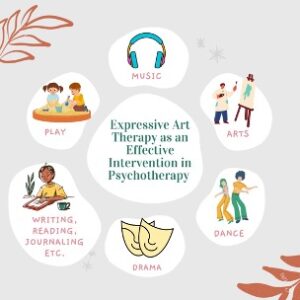EXPRESSIVE ARTS AS AN EFECTIVE INTERVENTION IN PSYCHOTHERAPY
“Art is to be moved, to love, to hope, to tremble, to live.”
-Auguste Rodin
Expressive Arts have always been an important interventional tool used by various psychotherapists. Its effectiveness was first identified during World War-I, when soldiers were reported to be miraculously cured. This happened as a result of them responding only to music and nothing else. However, in the 1930’s onwards, creative arts therapy became more widely known, as psychotherapists began to realize that for some clients talking about heavy emotions was extremely difficult, non-verbal methods like painting, drawing, music etc. might be helpful to treat severe mental illnesses and so, gradually creative arts began to find its place in therapy spaces. Now, creative art interventions are used by psychotherapists for not just clients with ‘severe mental illnesses’ but anyone who finds it difficult to express their issues verbally during therapy.
“Expressive arts therapy is used with children and adults, as individuals or in groups, to nurture deep personal growth and transformation. It can help clients review and make meaning of their lives, and tell their life stories, as well as help them engage with family and other significant people in their lives”, says Sammy, a therapist at Pause for Perspective.
“Usually, therapists inform their clients about their approach and their inclination towards expressive arts. They take their client’s consent and introduce activities when appropriate during the session”, says Shravni, a therapist at Pause for Perspective.
 Expressive Arts Therapy is a multimodal approach that involves certified therapists using all kinds of creative art forms like music, drawing painting, drama, writing poetry etc. Art therapy on the other hand involves usage of drawing, painting collage, coloring or sculpting and creating an artwork. Expressive Art based Therapists move freely between using the various modalities when appropriate during the session while Art therapists usually stick to only using art-based interventions. Art therapy is the most widely used form of expressive arts therapy by therapists around the world.
Expressive Arts Therapy is a multimodal approach that involves certified therapists using all kinds of creative art forms like music, drawing painting, drama, writing poetry etc. Art therapy on the other hand involves usage of drawing, painting collage, coloring or sculpting and creating an artwork. Expressive Art based Therapists move freely between using the various modalities when appropriate during the session while Art therapists usually stick to only using art-based interventions. Art therapy is the most widely used form of expressive arts therapy by therapists around the world.
Art interventions lead to strengthening the therapeutic relationship between the client and the therapist, because both people involved, collaboratively create a triangular relationship with the artwork. The therapist also becomes a key collaborator by providing the client a safe space and the tools to create the artwork. This helps the client to process and understand their emotions while externalizing them in the form of creative art expressions that are personal to the client. In short expressive arts therapy is using creative arts to walk on the road towards having better emotional health.
Sammy, a therapist at Pause for Perspective says “Most clients are quite surprised when they see the artwork or poetry they write. They find the creative process quite healing as they are able to create an aesthetic distance with the concerning issue.”
One is not required to be an artist to draw, a dancer to dance, an actor to act out a situation in a therapeutic setting. It is extremely important to understand that therapy is an extremely personal experience and as a result of which therapeutic interventions are personalized. The artwork you create in a session might not be the next Monalisa, but it definitely is a piece that you will hold close to your heart and go back to when you need a safe space or just to understand yourselves better.
– Afshin Ratnani
(Psychology Intern & Writer)
